19TH-CENTURY PORTRAITS ON SCORED PANELS IN THE CLEVELAND MUSEUM OF ART
CHRISTINA CURRIE
3 SCORING PATTERNS
The scoring patterns are invariably linear in character but differ in their direction, fineness, evenness, and spacing. The scoring lines in Jarvis's Thomas Abthorpe Cooper(fig. 1) are confined to the face, collar, and background. In all other Cleveland panels examined, the pattern covers the entire front surfaces. Three panels—Thomas Abthorpe Cooper, Stuart's Mrs. James Stuart (ca. 1815, Cleveland Museum of Art), and Frothingham's Samuel Barber Clark(fig. 2)—display diagonal scoring patterns running from the upper right to the lower left. The scoring in Waldo's Independent Beggar(fig. 3) follows the opposite diagonal. Both Jarvis's Benjamin Rouse(fig. 4) and Waldo and Jewett's Portrait of a Man(fig. 5) have linear scoring in both diagonals. However, the scoring in Portrait of a Man is so fine that it merely imparts a slight matte quality to the painting surface.
Fig. 1.
John Welsey Jarvis, Thomas Abthorpe Cooper, ca. 1810, oil on panel, 3315⅙ � 26 in. Cleveland Museum of Art, 18.173. Detail of x-radiograph showing the thin black lines that represent scoring through the ground layer
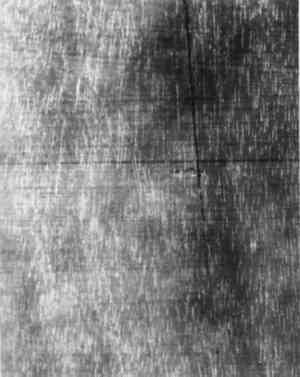 |
Fig. 2.
James Frothingham, Samuel Barber Clark, ca. 1810, oil on panel, 25⅛ � 211⅙ in. Cleveland Museum of Art, 19.1017. Detail of x-radiograph showing the thin white lines that represent incisions directly into the panel
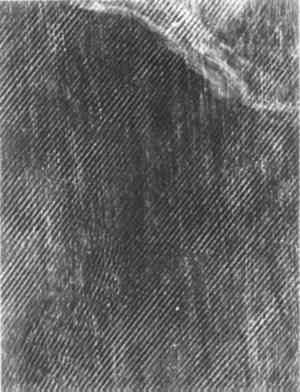 |
Fig. 3.
Samuel Lovett Waldo, Independent Beggar, ca. 1819, oil on panel, 1815⅙ � 149⅙ in. Cleveland Museum of Art, 16.998. In this x-ray detail, crude, uneven diagonal white lines reveal the scoring lines made into the panel.
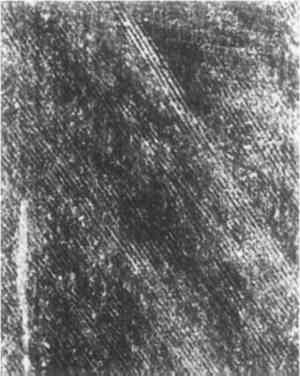 |
Fig. 4.
John Wesley Jarvis, Benjamin Rouse, ca. 1819, oil on panel. 2⅞ � 175⅙ in. Cleveland Museum of Art, 50.346. Detail of x-radiograph showing diagonal scoring in both directions done after ground application but cutting through the soft linden wood surface in most places. The incisions were later filled with opaque paint.
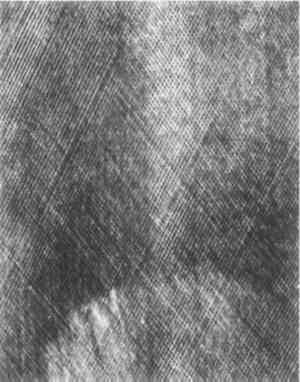 |
Fig. 5.
Samuel Lovett Waldo and William Jewett, Portrait of a Man, 1832, oil on panel, 36 � 277⅙ in. Cleveland Museum of Art, 47.206. Detail of x-radiograph showing diagonal scoring in both directions incised directly into the panel.
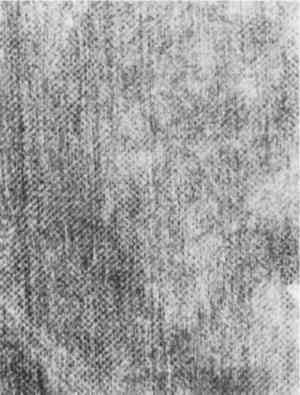 |
The nature of the pattern in this case is distinguishable only in the x-radiograph. The purpose of the scoring probably had more to do with “tooth” than with decorative effect. Jouett's Thomas Hart Benton(figs. 6, 7) is the only example displaying vertical incised lines.
Fig. 6.
Matthew Harris Jouett, Thomas Hart Benton, ca. 1820s, oil on panel, 295⅙ � 237⅙ in. Cleveland Museum of Art, 41.597. Detail of x-radiograph, with thin white stripes representing lead white-filled incisions
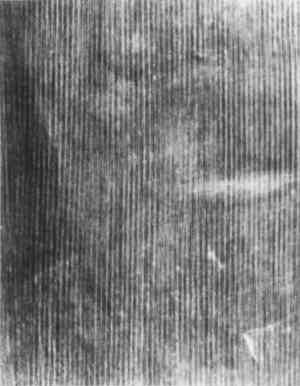 |
Fig. 7.
Detail, Matthew Harris Jouett, Thomas Hart Benton. Edge of panel showing that scoring was done prior to application of ground. ca. 4�
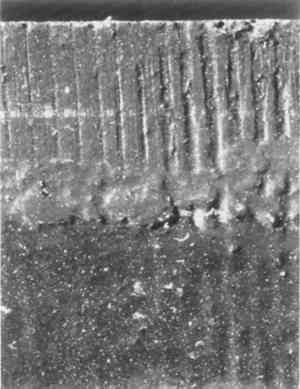 |
The linear incisions usually appear in groups indicating the width of the tool used, as, for example, in Benjamin Rouse (see fig. 4). This tool would have been either a plane held by two wooden handles or, more likely, a toothing plane consisting of a serrated blade held within a wooden casing (fig. 8), the blade measuring about 2–3 cm in width. Unlike the straightedged blades of ordinary planes, the serrated blade of the toothing plane was held in place almost vertically, and the wooden casing was a little shorter. Eric Sloane, in A Museum of Early American Tools (1964), illustrates an advertisement from the 1800s offering a wide selection of planes for carpenters, coopers, and cabinet and coach makers. Included in the advertisement are tooth planes, available in case steel for $1.25.
The use of a toothing plane for scoring the front of panels was a secondary application. Its more common use was the preparation of wood surfaces before joining or adding veneer. A typically “twilled” wood panel by Gilbert Stuart, William Codman (ca. 1812, private collection), provides evidence of this joining technique. Stuart's studio extended the panel, the additions clearly having been painted by the same hand. The joins are supported on the reverse by shallow wooden battens. The visible parts of these battens display a fine network of scoring in both diagonals, and there are traces of scoring lines on the original panel adjacent to the battens. Although it is impossible to see the inside of the join, the evidence suggests that the panel maker scored both the inside edges of the battens and the panel surfaces before adhesion, and it is to his credit that the joins are in perfect condition today. Prominent groups of incised lines were noted on the reverse of a small walnut panel by William Merritt Chase (Harbor Scene, ca. late 1870s, Cleveland Museum of Art). Since these lines are so irregularly and crudely applied, it is likely that they were also originally intended to provide tooth for adherence to another surface rather than a texture for reception of the ground and paint layers.
|







